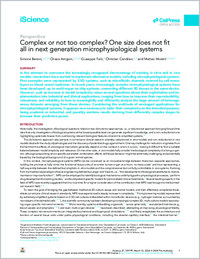Complex or not too complex? : One size does not fit all in next generation microphysiological systems
- Bersini, Simone ORCID Regenerative Medicine Technologies Lab, Laboratories for Translational Research, Ente Ospedaliero Cantonale, Bellinzona, Switzerland - Service of Orthopaedics and Traumatology, Department of Surgery, Ente Ospedaliero Cantonale, Lugano, Switzerland - Euler Institute (EUL), Università della Svizzera italiana, Switzerland
- Arrigoni, Chiara ORCID Regenerative Medicine Technologies Lab, Laboratories for Translational Research, Ente Ospedaliero Cantonale, Bellinzona, Switzerland - Service of Orthopaedics and Traumatology, Department of Surgery, Ente Ospedaliero Cantonale, Lugano, Switzerland - Euler Institute (EUL), Università della Svizzera italiana, Switzerland
- Talò, Giuseppe Cell and Tissue Engineering Laboratory, IRCCS Ospedale Galeazzi – Sant’Ambrogio, Milano, Italy
- Candrian, Christian ORCID Service of Orthopaedics and Traumatology, Department of Surgery, Ente Ospedaliero Cantonale, Lugano, Switzerland - Euler Institute (EUL), Università della Svizzera italiana, Switzerland
- Moretti, Matteo Regenerative Medicine Technologies Lab, Laboratories for Translational Research, Ente Ospedaliero Cantonale, Bellinzona, Switzerland - Service of Orthopaedics and Traumatology, Department of Surgery, Ente Ospedaliero Cantonale, Lugano, Switzerland - Euler Institute (EUL), Università della Svizzera italiana, Switzerland - Cell and Tissue Engineering Laboratory, IRCCS Ospedale Galeazzi – Sant’Ambrogio, via Cristina Belgioioso 173, 20157 Milano, Italy
- 2024
Published in:
- iScience. - 2024, vol. 27, no. 3, p. 109199
English
In the attempt to overcome the increasingly recognized shortcomings of existing in vitro and in vivo models, researchers have started to implement alternative models, including microphysiological systems. First examples were represented by 2.5D systems, such as microfluidic channels covered by cell monolayers as blood vessel replicates. In recent years, increasingly complex microphysiological systems have been developed, up to multi-organ on chip systems, connecting different 3D tissues in the same device. However, such an increase in model complexity raises several questions about their exploitation and implementation into industrial and clinical applications, ranging from how to improve their reproducibility, robustness, and reliability to how to meaningfully and efficiently analyze the huge amount of heterogeneous datasets emerging from these devices. Considering the multitude of envisaged applications for microphysiological systems, it appears now necessary to tailor their complexity on the intended purpose, being academic or industrial, and possibly combine results deriving from differently complex stages to increase their predictive power.
- Collections
- Language
-
- English
- Classification
- Medicine
- License
- Open access status
- gold
- Identifiers
-
- DOI 10.1016/j.isci.2024.109199
- ARK ark:/12658/srd1328320
- Persistent URL
- https://n2t.net/ark:/12658/srd1328320
Statistics
Document views: 126
File downloads:
- Bersini_2024_iscience: 131
